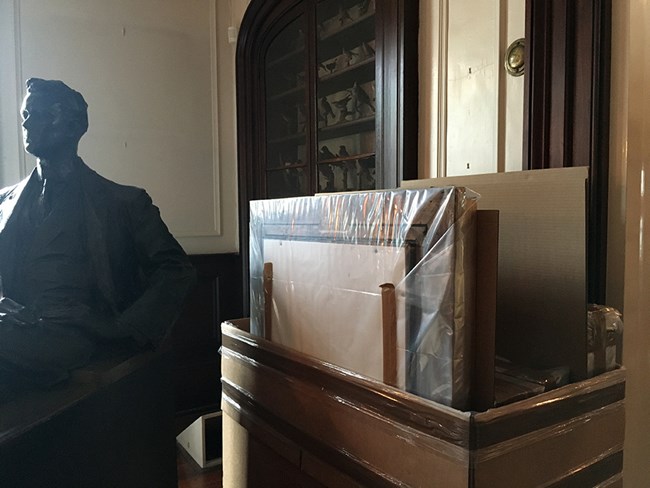Last updated: April 5, 2020
Article
Restoring the President's Home

NPS Photo
Preservation never ends for the more than 50 historic structures, five gardens, and over a thousand acres of landscapes, woodlands, and trails managed by the National Park Service in Hyde Park, New York. Our team of preservation experts work every day to protect these historic and natural features from exposure to weather and wear put on them by half a million visitors each year.
Maintaining FDR's home requires an ongoing program of conservation. Work currently underway includes exterior structure repairs and painting, interior plaster repairs and painting, mechanical and fire protection system upgrades, and the conservation of furnishings. In all we do, the National Park Service works to preserve the home of FDR for the enjoyment of generations to come.

NPS Photo
NPS carpenters trained in historic building preservation methods restore damaged plaster in an alcove of the dining room at Springwood utilizing19th century materials and techniques. Plaster was commonly used in historic buildings for walls and ornamentation. Traditional lime plaster, widely used in historic preservation for its durability and intrinsic beauty, is built up with layers and then shaped to match the original moulding profile. Proper proportioning and mixing of materials is vital to the quality of the plaster job. Our carpenters use lime putty produced in Italy and aged over 24 months. The entire process takes several days to prepare the surface and shape the moulding. After the plaster has properly cured, it will receive a finish coat and paint.

NPS Photo
Conserving the President's Books
The library collections at the Home of Franklin D. Roosevelt NHS are broad and in varying states of condition. The main library in the house represents an important feature of the president’s house. With only a few exceptions, most of the books are not rare, but are important because they represent the nature of FDR’s reading, his family heritage, and his collecting interests. The condition of the books vary greatly—some are heavily damaged, while others need only minor repairs to the bindings and dust jackets.
The entire collection, approximately 4,000 volumes, was subject of a 2007 condition survey. At that time, only one-quarter of the collection was considered stable. Many books have loose bindings, loose or detached cover boards, red rot, and damage from mold, making handling and cyclic cleaning difficult. Treatments to date have stabilized books with the most critical and extensive needs. National Park Service conservators, with assistance from student interns, are addressing the preservation needs over the course of several years. Prioritization for treatments are based on condition and visual cohesion of the entire library in effort to improve exhibits for public viewing.

NPS Photo
Repairing and Painting Exterior Wood Elements
Wooden components of historic buildings are highly reactive to environmental conditions, requiring periodic repair or replacement. The National Park Service, in compliance with the Secretery of the Interior's standards for the preservation of historic buildings, makes every attempt to save original building fabric. Occasionaly, these components require replacement with similar new material. The current work on the exterior of Springwood includes a variety of approches to return the president's house to a stable condition. Failing paint layers expose original wood fabric to further damage from weather. After damaged wood is repaired, new paint will protect over 1,500 linear feet of cornice, soffit, facia, and foundation skirt, 13 doors, 16 columns, and the trim of 106 windows.

NPS Photo
Preparing the Museum Collections
The museum collection for the Home of Franklin D. Roosevelt National Historic Site includes over 9,000 furnsihings, artworks, photographs, decorative objects, household linens—all the things one finds in living rooms, dining rooms, bedrooms, kitchens, and even the closets of a home. Approximately 6,000 of those historic objects are on exhibit in Springwood. The park's curatorial team spent months in planning and preparing for the removal and protection of museum collections during the interior restoration work. Some items are determined to have adequate protection and will remain the house. Those that are more sensitive to the environmental conditions that are expected for the duration of the project were relocated to the park's collections storage facility. The movement of every object is carefuly recorded and verified. When the work is complete, the park's curatorial team will give the house a thorough cleaning and return each object to its original location, restoring the rooms to the way the Roosevelts left them.
